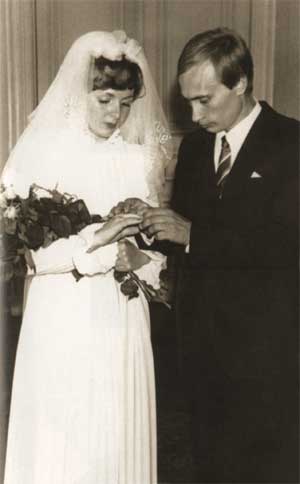EARLY LIFE
Vladimir Putin was born in a middle class family on October 7, 1952, in Leningrad (now St Petersburg), Russian SFSR, Soviet Union.
His parents were Vladimir Spiridonovich Putin (1911–1999) and Maria Ivanovna Putina (née Shelomova; 1911–1998).
Vladimir Putin's grandfather worked as a chef for Rasputin, Lenin and Stalin.
Putin's family lived in a communal apartment, which was a large apartment that was shared by several families. The apartment was infested with rats, which were a common problem in Leningrad at the time. Putin has said that he remembers the rats running around the apartment and that he would often wake up to find them on his bed. The experience of living in a rat-infested apartment left a lasting impression on him.
Putin studied German at St Petersburg High School 281 and speaks the language fluently.
He studied Law at the St Petersburg State University, graduating in 1975. His thesis was on "The Most Favored Nation Trading Principle in International Law."
Putin had dreamed of becoming an intelligence officer ever since he was a child and his prowess at judo brought him to the attention of the security services and saved him from a life of street crime. In 1975, he joined the KGB, training at the 401st KGB school in Okhta, Leningrad.
Putin was a KGB Foreign Intelligence Officer for 16 years. From 1985 to 1989, he worked in Dresden, East Germany.
After East Germany collapsed in 1989, Putin was told to return to the Soviet Union. He chose to go to Leningrad, where he'd attended university.
In June 1990, he started working in the International Affairs section of Leningrad State University and the following year, Putin was appointed head of the International Committee of the Saint Petersburg Mayor's office. His job was to promote international relations and foreign investments.
Putin gave up his position in the KGB on August 20, 1991, during the putsch against Soviet President Mikhail Gorbachev.
In 1991 Putin entered politics and three years later, he became First Deputy Chairman of the city of Saint Petersburg.
Putin shifted to Moscow in August 1996, along with his family and there he served in a variety of important positions in Boris Yeltsin's government. He was director of the FSB (a newer version of the KGB) from July 1998 to August 1999, and Secretary of the Security Council from March to August 1999.
On August 9, 1999, Russian President Boris Yeltsin fired his Prime Minister, Sergei Stepashin, and for the fourth time fired his entire cabinet. Vladimir Putin was appointed one of three First Deputy Prime Ministers, and later on that day was appointed acting Prime Minister of the Government of the Russian Federation.
At the end of that year, Yeltsin stepped down as President. nominating Putin as his successor.
Putin won the subsequent 2000 Presidential election by a 53% to 30% margin, thus avoiding a runoff with his Communist Party of the Russian Federation opponent, Gennady Zyuganov. He was re-elected President in 2004 with 72% of the vote.
Vladimir Putin was sworn in as president of Russia, on May 7, 2000. He served as Russian president from 2000-2008.
During Putin's first period as president, the Russian economy grew for eight straight years, and GDP measured in purchasing power increased by 72%.
In 2007, Putin was the Time Person of the Year.
According to the Constitution of Russia, no-one can be president three times in a row. Because of this, Putin didn't put himself forward for the March 2008 election, so he served as Prime Minister under the presidency of Dmitry Medvedev from 2008-2012.
However, one can be president as many times as you want, as long as it's not for more than two times in a row. In September 2011, after presidential terms were extended from four to six years, Putin put himself forward for the elections, and in March 2012 he was re-elected as president, winning 64% of the vote. He is also leader of the ruling United Russia party.
On March 24, 2014, Putin and Russia were suspended from the G8 after Russia's annexation of Crimea and military intervention in Eastern Ukraine.
Putin gained 76% of the March 2018 presidential vote, and was re-elected for a six-year term that will end in 2024.
Putin married Lyudmila Shkrebneva, a flight attendant for the Kaliningrad branch of Aeroflot on July 28, 1983. They had been courting for three years.
The couple had two daughters, Mariya (born April 28, 1985, Leningrad, Soviet Union) and Yekaterina (Katja) (born August 31, 1986, in Dresden, East Germany).
After Vladimir's rise to political power, Lyudmila maintained a low profile on the Russian political stage, generally avoiding the limelight except as required by protocol and restricting her public role to supportive statements about her husband.
On June 6, 2013, Lyudmila Putina and her husband publicly announced their divorce based on a mutual decision.
Putin is close friends with ex Italian premier Silvio Berlusconi. After Berlusconi was banned from the Italian parliament in 2013, Putin reportedly offered him Russian citizenship. Most strangely, the former Italian leader gave Putin a duvet emblazoned with a life-size image of the two to celebrate his 65th birthday.
Putin is a member of the Russian Orthodox Church, and regularly attends the most important services of the church on the main Orthodox Christian holidays.
Putin began training in sambo (a martial art form) at the age of 14, before switching to judo, for which he gained a black belt and continues to take part in. Putin also practices karate.
Putin has a passion for adventure sports. He has done several well-documented publicity stunts, including saving a TV crew from a Siberian tiger. He later acknowledged they were all staged.
Vladimir Putin walks with his right arm held immobile while his left arm swings because of his KGB training—he keeps his gun arm close.
Putin studied German at St Petersburg High School 281 and speaks the language fluently.
He studied Law at the St Petersburg State University, graduating in 1975. His thesis was on "The Most Favored Nation Trading Principle in International Law."
CAREER IN KGB
Putin had dreamed of becoming an intelligence officer ever since he was a child and his prowess at judo brought him to the attention of the security services and saved him from a life of street crime. In 1975, he joined the KGB, training at the 401st KGB school in Okhta, Leningrad.
 |
| Putin in KGB uniform, c. 1980 |
Putin was a KGB Foreign Intelligence Officer for 16 years. From 1985 to 1989, he worked in Dresden, East Germany.
After East Germany collapsed in 1989, Putin was told to return to the Soviet Union. He chose to go to Leningrad, where he'd attended university.
In June 1990, he started working in the International Affairs section of Leningrad State University and the following year, Putin was appointed head of the International Committee of the Saint Petersburg Mayor's office. His job was to promote international relations and foreign investments.
Putin gave up his position in the KGB on August 20, 1991, during the putsch against Soviet President Mikhail Gorbachev.
EARLY POLITICAL CAREER
In 1991 Putin entered politics and three years later, he became First Deputy Chairman of the city of Saint Petersburg.
Putin shifted to Moscow in August 1996, along with his family and there he served in a variety of important positions in Boris Yeltsin's government. He was director of the FSB (a newer version of the KGB) from July 1998 to August 1999, and Secretary of the Security Council from March to August 1999.
 |
| Putin as FSB director, 1998. By RIA Novosti archive, Wikipedia |
PRESIDENCY
On August 9, 1999, Russian President Boris Yeltsin fired his Prime Minister, Sergei Stepashin, and for the fourth time fired his entire cabinet. Vladimir Putin was appointed one of three First Deputy Prime Ministers, and later on that day was appointed acting Prime Minister of the Government of the Russian Federation.
At the end of that year, Yeltsin stepped down as President. nominating Putin as his successor.
Putin won the subsequent 2000 Presidential election by a 53% to 30% margin, thus avoiding a runoff with his Communist Party of the Russian Federation opponent, Gennady Zyuganov. He was re-elected President in 2004 with 72% of the vote.
Vladimir Putin was sworn in as president of Russia, on May 7, 2000. He served as Russian president from 2000-2008.
 |
| Putin taking presidential oath beside Boris Yeltsin, May 2000. By Presidential Press and Information Office |
During Putin's first period as president, the Russian economy grew for eight straight years, and GDP measured in purchasing power increased by 72%.
In 2007, Putin was the Time Person of the Year.
According to the Constitution of Russia, no-one can be president three times in a row. Because of this, Putin didn't put himself forward for the March 2008 election, so he served as Prime Minister under the presidency of Dmitry Medvedev from 2008-2012.
However, one can be president as many times as you want, as long as it's not for more than two times in a row. In September 2011, after presidential terms were extended from four to six years, Putin put himself forward for the elections, and in March 2012 he was re-elected as president, winning 64% of the vote. He is also leader of the ruling United Russia party.
 |
| By Kremlin.ru, https://commons.wikimedia.org/w/index.php?curid=40763566 |
On March 24, 2014, Putin and Russia were suspended from the G8 after Russia's annexation of Crimea and military intervention in Eastern Ukraine.
Putin gained 76% of the March 2018 presidential vote, and was re-elected for a six-year term that will end in 2024.
PRIVATE LIFE
Putin married Lyudmila Shkrebneva, a flight attendant for the Kaliningrad branch of Aeroflot on July 28, 1983. They had been courting for three years.
 |
| Putin and Lyudmila Putina at their wedding, 28 July 1983 |
The couple had two daughters, Mariya (born April 28, 1985, Leningrad, Soviet Union) and Yekaterina (Katja) (born August 31, 1986, in Dresden, East Germany).
After Vladimir's rise to political power, Lyudmila maintained a low profile on the Russian political stage, generally avoiding the limelight except as required by protocol and restricting her public role to supportive statements about her husband.
On June 6, 2013, Lyudmila Putina and her husband publicly announced their divorce based on a mutual decision.
Putin is close friends with ex Italian premier Silvio Berlusconi. After Berlusconi was banned from the Italian parliament in 2013, Putin reportedly offered him Russian citizenship. Most strangely, the former Italian leader gave Putin a duvet emblazoned with a life-size image of the two to celebrate his 65th birthday.
Putin is a member of the Russian Orthodox Church, and regularly attends the most important services of the church on the main Orthodox Christian holidays.
 |
| Putin attends the Orthodox Christmas service in the Tver region, 7 January 2016 |
Putin began training in sambo (a martial art form) at the age of 14, before switching to judo, for which he gained a black belt and continues to take part in. Putin also practices karate.
Putin has a passion for adventure sports. He has done several well-documented publicity stunts, including saving a TV crew from a Siberian tiger. He later acknowledged they were all staged.
Vladimir Putin walks with his right arm held immobile while his left arm swings because of his KGB training—he keeps his gun arm close.






























